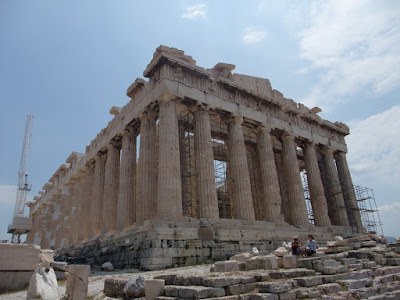Early on the morning of July 7th, we arrived in Athens, Greece. Athens, the capital and largest city of Greece, dominates the Attica periphery; as one of the world’s oldest cities, its history spans around 3,400 years. The previous sentence was in no way, shape, or form copied from the Wikipedia article on Athens. Any similarities between this blog post and the aforementioned Wikipedia article are entirely coincidence, and are certainly not due to unabashed plagiarism. Really.*
*Not really.
My family had decided beforehand that we didn’t want the typical tourist experience during our brief stay in Athens. We wanted to avoid the tourist traps and mobs of foreigners. We wanted to see the authentic city and culture as the locals did. That is to say, we decided to visit the Parthenon, shown in the obligatory Touristy Parthenon Photograph below:
Something I found rather intriguing about the Parthenon and surrounding area is how close the ancient temple and the modern city are. I suppose that it makes sense that the ruins should be smack in the center of town, because with three and a half millennia of uninterrupted inhabitation, it wouldn’t make sense for modern Athens to be any great distance from ancient Athens. Nevertheless, I found juxtaposed views like this one quite breathtaking:
Sadly, after only six hours in Athens, it was time to pack up and return to the ship, all set to embark to…
Kuşadası!
We arrived in Kuşadası*, Turkey, at about 6 am on July 8th. As in Athens, we only had about six hours, so we took a guided tour in order to see as much as possible in our limited time. A little background: Kuşadası is a small seaside city on the Asia Minor portion of Turkey, meaning that it was my mother’s and sister’s first time in Asia (I spent about three and a half weeks in Asia in December and January). The town itself is quite touristy, with a summertime population of about ten times its winter numbers. In Kuşadası’s case, the extensive tourism is certainly deserved, because Kuşadası is very close to the Ephesian ruins. The ancient Greek city of Ephesus is home to an archaeological site larger than Pompeii, one of the Seven Wonders of the Ancient Word (The Temple of Artemis), Saint John’s Basilica, and what is generally regarded as the Virgin Mary’s final resting place. The inhabitants of Ephesus also had the distinction of having a Biblical book written to them (the Book of Ephesians).
*I like writing about Kuşadası because I feel very clever typing the funky ş and ı
Above is a photograph of the exterior of the Virgin Mary’s House. This is actually a reconstruction of the original, which collapsed at some point over the centuries between its initial construction and when it was rediscovered by the Holy Roman Empire. Nevertheless, the foundations remained intact, and it was upon these original foundations that this reconstruction was built. I was surprised by how modest the house was – the final resting place of Saint Mary is a very important and holy place for billions of people around the world, and I was surprised that it had remained the same humble house that Mary herself had lived and died in. Near the shrine was a wall covered with prayers in dozens of languages written on cloth.
After seeing the Virgin Mary’s shrine, we continued our exploration of Christian history by visiting the remains of St. John’s Basilica, a photograph of which is shown below. I learned in Kuşadası that a church must contain a relic of the person for whom it is named in order to qualify as a Basilica; however, dear reader, please take this definition with a grain of salt, as I was unable to find corroboration anywhere on the Internet. St. John’s Basilica was supposedly built upon the spot where the Saint himself died, making it one of the most significant religious ruins in the world.
At this point, the poor Roe family was very overheated and exhausted – I assure you, Turkey in July is not for the faint of heart! Nevertheless, we managed to pull together a last rally and visit the ruins of Ephesus before returning to the ship. As I mentioned before, Ephesus is one of the largest ancient Greek ruins in the world, although it is currently only 15% excavated. A lot of work is still being done in the area, and we spotted a few archaeologists running around with their very professional looking tools during our exploration.
Here is a photograph that shows a very, very, very small portion of the excavated ruins of Ephesus. Ephesus is located in a valley and surrounded by mountains, and you can see a hint of the scrubby hills all around it behind the ruins.
Saturday, July 24, 2010
Subscribe to:
Post Comments (Atom)







No comments:
Post a Comment